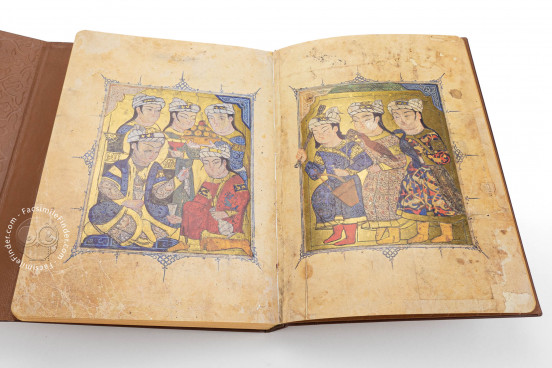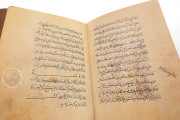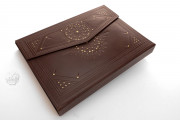The Sulwān al-Mutā' Fī 'Udwān al-Atbā' is a manuscript on paper, produced in Damascus between 1330 and 1334. The importance of the manuscript goes beyond its curious history. This is not only a volume of princely quality, executed in the same workshop as the famous copy of the Maqāmāt al Harīrī dated 1334 CE that is now kept in the Nationalbibliothek of Vienna. The illuminated copy of the Sulwān al-Mutā' raises important questions about Arab culture.
Ethics & Teachings of Islam Produced as Parables
Unlike the Maqamat, or other illustrated manuscripts from the Arab world, this manuscript reproduces the text of a book of ethics rooted in the teachings of Islam. The work was conceived by a 12th century ascetic, Ibn Zafar al-Siqilli, who is also the author of a major commentary on the Koran.
The Sulwān al-Mutā' belongs to a genre that has no equivalent in Western literature: it is a book of theological and practical ethics illustrated with parables. The structure of the work is determined by a succession of concepts, not by a plot.
The five chapters deal with different stages in the true believer's spiritual progression. All chapters open with Quranic verses and teachings by the Prophet (hadith), introducing rules of conduct illustrated with parables. Princely characters, essentially from Ancient Persian history, alternate to chapters in the form of animal fables. Throughout the book, the tone is pungent, even relentless. Despite the title, this is a bitter diatribe against injustice, social exploitation, and political oppression.
The five chapters of approximately equal length deal with one of the five "comforts" offered to "Kings." They correspond to the five spiritual attitudes to be observed on the path followed by Muslim mystics: I. tawfīḍ or total trust in God, 2. ta'assī or comforting oneself (while suffering), 3. ṣabr or patience, 4. riḍa or contentment, 5. zuhd or asceticism/self-denial. The arrangement follows a sequence that implicitly points to the notion of the 'spiritual path,' in Arabic tariqa, the word also used to describe the different Sufi path orders.
This highly conceptual approach with a progression of spiritual concepts is common to all Arab, and indeed, all Middle Eastern writers, and Arab figurative art. What the Sulwān al-Mutā' reveals for the first time is the transition from the old thematic art with its monumental figures, timeless and spaceless, to a new art of which the essence is stylized action in settings that are given equal or even greater importance than the human element.
A Unique Stylistic Art Form
The stylistic handling of the Sulwān al-Mutā' miniatures is entirely original, although it still carries the unmistakable stamp of the Arab vision with its permanent penchant for baroque forms and expressiveness. The stylistic coherence points to certain self-confidence on the part of the artist, or, perhaps, the artists.
A common feature of the miniatures is the double fillets in black ink running along the edges of the image, one marking off the gold background, the other running over it.
In the compositions in which characters play an exclusive role – ten out of thirty – outsized figures fill the space too small to contain them. Even where the figures do not give the impression of having been compressed into a cramped space, a trompe l'oeil is created as if to suggest that they are bursting out of the frame. It is also used to create the illusion of depth.
The use of architecture in the composition as well as the same repertoire of human archetypes and clothes provides close parallels between the 1334 Maqāmāt and the Sulwān: "the moon-face" and conventional types reproduced in both manuscripts closely match each other. One is "the mature man", with a black beard and heavy drooping mustache, another one is "the white-beard.”
In short, the wide range of characteristic features common to the Sulwān and the Maqāmāt al Harīrī, many of which are otherwise unparalleled, leaves little doubt that the two manuscripts are products of the same artistic center.
Innovations in Arab Book Arts
For the first time in the history of Arab book arts, perspective is introduced into some of the miniatures, possibly with Far Eastern or Chinese influence. Another innovation in the Sulwān landscapes is the introduction of natural plants which, despite stylization, are identifiable, in contrast to the formalized vegetal motifs characteristic of Arab painting in the previous century and in some other 14th century manuscripts.
The Sulwān al-Mutā' landscape scenes with Far Eastern elements are executed in a highly original style. The artist felt sufficiently at home in this new artistic language to innovate boldly. He created in it one of the earliest surviving landscapes painted as a separate image in the Islamic art of the book.
The thoughts are expressed in thoroughly Koranic words as always with Ibn Zafar, who is imbued with the teachings of the Koran. The painting appears on the verso of the page describing the corresponding moment in the story.
The gold background and the drapery-like sky hanging over the scene add the finishing touches to this purely conceptual landscape, in which form and color do not represent what the eye sees but convey literary metaphors - the light that is pure gold, the sky of lapis-lazuli color, the flowers that are like gems, the earth in which faces are to be seen. The image is truly a mental illustration.
For the first time in Arab book painting, the vertical format is extensively used throughout the manuscript-less than one-quarter of the images are in the old horizontal format. For the first time too, excepting the frontispiece in the related Vienna Maqāmāt manuscript, color is used to create a rhythm in the composition.
An Astonishing History and Discovery
The abrupt ending of Arab painting in the second half of the 14th century is one of the unresolved mysteries of Islamic history. The discovery of the Sulwān al-Mutā' deepens this mystery. It shows that the art not only stood very high when it was about to vanish, but also that it had the ability to renovate itself. The manuscript seems to be heralding a new era, during which miniature painting instead stopped being produced.
The Sulwān was likely produced in Syria within the same broad period as the Maqāmāt. With regard to the Sulwān itself, its author died in Syria and the earliest owners who left their marks on the title page were Syrian too. Unfortunately, the ownership records were inscribed at least two centuries after the execution of the book, which could easily have traveled over great distances.
The Sulwān al-Mutā' Fī 'Udwān al-Atbā' wasn’t thought to exist until part of the title page first emerged at a sale in Paris in 1973. Shortly following this, the manuscript appeared in an auction, first in Paris and then in London, where it was purchased by Mr. Homaizi.
Finding the manuscript was one of the most astonishing discoveries in the history of Arab painting since the unveiling of the 8th century AD Syrian frescoes at Qaṣr al-Ḥayr al Gharbī, which were studied and made public by Daniel Schlumberger in 1948. The manuscript currently resides in the Jasim al Homaizi collection at the Museum of Islamic Art in Qatar.
We have 1 facsimile edition of the manuscript "Sulwan al-Muta' Fi 'Udwan al-Atba'": Sulwān al-Mutā' Fī 'Udwān al-Atbā' facsimile edition, published by TRI Publishing Co., 1985
Request Info / Price

























